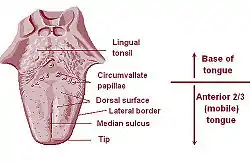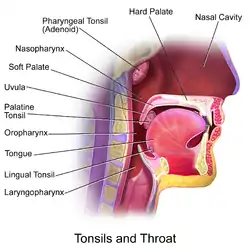Lingual tonsils
The lingual tonsils are a collection of lymphatic tissue located in the lamina propria of the root of the tongue.[1] This lymphatic tissue consists of the lymphatic nodules rich in cells of the immune system (immunocytes).[2] The immunocytes initiate the immune response when the lingual tonsils get in contact with invading microorganisms (pathogenic bacteria, viruses or parasites).[2][3][4]
| Lingual tonsils | |
|---|---|
 Tongue | |
| Details | |
| System | Immune system (Lymphatic system) |
| Identifiers | |
| Latin | tonsilla lingualis |
| TA98 | A05.1.04.022 |
| TA2 | 2830 |
| FMA | 54836 |
| Anatomical terminology | |
Structure
Microanatomy
Lingual tonsils are covered externally by stratified squamous nonkeratinized epithelium that invaginates inward forming crypts. Beneath the epithelium is a layer of lymphoid nodules containing lymphocytes. Mucous glands located at the root of tongue are drained through several ducts into the crypt of lingual tonsils.[2][3] Secretions of these mucous glands keep the crypt clean and free of any debris.
Blood supply
Lingual tonsils are located on posterior aspect of tongue which is supplied through:[1]
- Lingual artery, branch of external carotid artery
- Tonsillar branch of facial artery
- Ascending and descending palatine arteries
- Ascending pharyngeal branch of external carotid artery
Nerve supply
Lingual tonsils are innervated by tonsillar nerves from the tonsilar plexus, formed by the glossopharyngeal and vagus nerves.[1]
Function

Like other lymphatic tissues, the function of lingual tonsils is to prevent infections. These tonsils contain B and T lymphocytes which get activated when harmful bacteria and viruses come in contact with tonsils. B lymphocytes kill pathogens by producing antibodies against them, while T lymphocytes directly kill them by engulfing them or indirectly by stimulating other cells of the immune system.[2][3][4]
Clinical significance
Cancer
Squamous cell carcinoma is a type of neoplasm that can affect lingual tonsils.[5]
Sleep apnea
Enlarged or hypertrophic lingual tonsils have the potential to cause or exacerbate sleep apnea.[6]
Additional images
 Lingual tonsil
Lingual tonsil Lingual tonsil
Lingual tonsil Lingual tonsils
Lingual tonsils
![]() This article incorporates text in the public domain from page 1138 of the 20th edition of Gray's Anatomy (1918)
This article incorporates text in the public domain from page 1138 of the 20th edition of Gray's Anatomy (1918)
External links
- Pictures at usc.edu(Registration required)
- Anatomy Atlases - Microscopic Anatomy, plate 09.163
- Histology image: 09802loa – Histology Learning System at Boston University
- MedEd at Loyola histo/HistoImages/hl6-27.jpg (labeled as 'lymphoid tissue')]
- Lingual Tonsil
References
- Moore, Keith L. (2013-02-13). Clinically oriented anatomy. Dalley, Arthur F., II,, Agur, A. M. R. (Seventh ed.). Philadelphia. ISBN 978-1451119459. OCLC 813301028.
- Mescher, Anthony L. (22 February 2013). Junqueira's basic histology : text and atlas. Junqueira, Luiz Carlos Uchôa, 1920- (Thirteenth ed.). New York. ISBN 9780071807203. OCLC 854567882.
- Ross, Michael H. (2011). Histology : a text and atlas : with correlated cell and molecular biology. Pawlina, Wojciech. (6th ed.). Philadelphia: Wolters Kluwer/Lippincott Williams & Wilkins Health. ISBN 9780781772006. OCLC 548651322.
- Abbas, Abul K. (2012). Cellular and molecular immunology. Lichtman, Andrew H., Pillai, Shiv. (7th ed.). Philadelphia: Elsevier/Saunders. ISBN 9781437715286. OCLC 698580696.
- Theodoraki, M-N.; Veit, J. A.; Hoffmann, T. K.; Greve, J. (2017-06-26). "Synchronous bilateral tonsil carcinoma: case presentation and review of the literature". Infectious Agents and Cancer. 12: 38. doi:10.1186/s13027-017-0146-5. ISSN 1750-9378. PMC 5485684. PMID 28670333.
- Badełek-izdebska, Małgorzata; Dębska, Małgorzata; Zawadzka-Głos, Lidia (2015-12-23). "Lingual Tonsil Hypertrophy as a Cause of Obstructive Sleep Apnea Syndrome – Case Report". New Medicine. 19 (4): 130–132. doi:10.5604/14270994.1191789. ISSN 1427-0994.